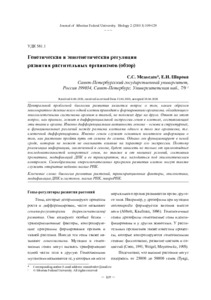Генетическая и эпигенетическая регуляция развития растительных организмов (обзор)
Скачать файл:
URI (для ссылок/цитирований):
https://elib.sfu-kras.ru/handle/2311/2141Автор:
Медведев, С.С.
Medvedev, Sergey S.
Шарова, Е.И.
Sharova, Elena I.
Дата:
2010-06Аннотация:
Центральной проблемой биологии развития является вопрос о том, каким образом
многократное деление всего одной клетки приводит к формированию организма, обладающего
многоклеточными системами органов и тканей, не похожих друг на друга. Ответ на этот
вопрос, как правило, лежит в дифференциальной экспрессии генов в клетках, составляющих
эти ткани и органы. Именно дифференциальная активность генома - основа и структурных,
и функциональных различий между разными клетками одного и того же организма, т.е.
клеточной дифференцировки. Именно геном служит основным носителем информации о
том, как растению пройти путь от семени до семени. Однако ген функционирует в некой
среде, которая не может не оказывать влияние на характер его экспрессии. Поэтому
реализация информации, заключенной в геноме, будет зависеть не только от нуклеотидных
последовательностей конкретных генов, но также и от внешних условий, состояния
хроматина, модификаций ДНК и ее транскриптов, т.е. находиться под эпигенетическим
контролем. Своеобразными «переключателями» программ развития клеток могут также
служить открытые недавно малые РНК. The completion of the Arabidopsis thaliana genome sequencing in 2000 was the key event in plant
biology. Over the past 10 years, genomes of another three plant species (rice, alfalfa and poplar) were
almost completely sequenced. The sequencing of maize, wheat, barley, vine and tomato genomes is in
progress. It is arising a new science - genomics, that investigates nucleotide composition of genome,
principles of individual genes and their complexes functioning, as well as genome evolution. Biology
turns into so called post-genomic period of its history, in which predominant researches start with
genome and protein sequencing and complete with determination of individual genes and proteins
functions, and their evolutionary origin too. On the other hand, genes activity depends not only on
the transcription factors specific to the given genes but also on the whole complex of factors able
to directly or indirectly influence chromatin structure. For this reason, realization of information
enclosed in genome depends not only on nucleotide sequence of given genes but also on environment,
chromatin state, modifications of DNA and its transcripts, i.e. it is under epigenetic control. Epigenetic
state of plant organisms is determined by levels and patterns of DNA methylation, post-translational
modifications of histones, the presence of histone variants and chromatin compaction. Recently
discovered noncoding microRNAs, playing key role in genes silencing by cleavage of genes transcripts
or by repression of mRNA translation, may serve as a kind of «switches» for cell developmental
programs. It is becoming evident that small RNAs perform a wealth of key functions in eukaryotic
organisms, and therefore it is now impossible to use the simple scheme «DNA-RNA-protein» for
description of genome work. In the article, it is discussed the role that transcription factors, small
RNAs, modifications of DNA and chromatin play in the regulation of plant growth and development.

